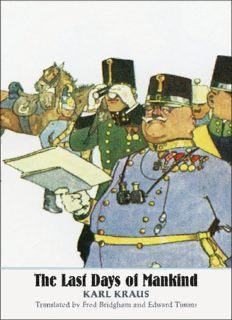
The Last Days of Mankind: The Complete Text PDF
Preview The Last Days of Mankind: The Complete Text
The Last Days of Mankind The Last Days of Mankind KARL KRAUS THE COMPLETE TEXT TRANSLATED BY FRED BRIDGHAM AND EDWARD TIMMS WITH A GLOSSARY AND INDEX YALE UNIVERSITY PRESS NEW HAVEN & LONDON The Margellos World Republic of Letters is dedicated to making literary works from around the globe available in English through translation. It brings to the English- speaking world the work of leading poets, novelists, essayists, philosophers, and playwrights from Europe, Latin America, Africa, Asia, and the Middle East to stimulate international discourse and creative exchange. The translation of this book was supported by the Austrian Federal Chancellery—Division for the Arts. Originally published as Die letzten Tage der Menschheit. Translated 2015 by Fred Bridgham and Edward Timms. English translation, introduction, and afterword copyright © 2015 by Yale University. All rights reserved. This book may not be reproduced, in whole or in part, including illustrations, in any form (beyond that copying permitted by Sections 107 and 108 of the U.S. Copyright Law and except by reviewers for the public press), without written permission from the publishers. Yale University Press books may be purchased in quantity for educational, business, or promotional use. For information, please e-m ail [email protected] (U.S. office) or sales@ yaleup.co.uk (U.K. office). Set in Electra type by Tseng Information Systems, Inc. Printed in the United States of America. Frontispiece: The execution of Cesare Battisti, 12 July 1916 Library of Congress Control Number: 2015939015 ISBN 978- 0- 300- 20767- 5 (cloth : alk. paper) A catalogue record for this book is available from the British Library. This paper meets the requirements of ANSI/NISO Z39.48- 1992 (Permanence of Paper). 10 9 8 7 6 5 4 3 2 1 CONTENTS Plan of Vienna City Centre, 1905 vi Introduction: Falsehood in Wartime, by Edward Timms and Fred Bridgham ix Preface, by Karl Kraus 1 Dramatis Personae 3 Prologue 29 Act I 47 Act II 168 Act III 240 Act IV 318 Act V 418 Epilogue: The Final Night 553 Translators’ Afterword and Acknowledgments 591 Glossary and Index 601 Map of European Battle Zones of the First World War 646 Plan of Vienna City Centre, 1905 This page intentionally left blank INTRODUCTION: FALSEHOOD IN WARTIME Edward Timms and Fred Bridgham The early twentieth century was the great age of the newspaper press, as mass literacy endowed the printed word with unprecedented power. Newspaper production was revolutionized by rotary presses and linotype compositing ma- chines, while modern roads and railways, together with the telephone, tele- graph, and teleprinter, were transforming communications. In Western Europe and North America democratic institutions, social reforms, and scientific dis- coveries seemed to be laying the foundations for a new era in the history of mankind. But it was also a period of intense imperial rivalries, backed by highly trained forces and sophisticated armaments industries. Given the precarious international situation, it was possible at moments of crisis for journalists to tip the balance between peace and war. Liberal papers such as the Manchester Guardian (edited by C. P. Scott) and the New York Times (under Adolph Ochs) may have been committed to the peaceful resolution of conflicts, but wars were good for newspaper sales. Moreover, wealthy proprietors like Hearst and North- cliffe, Hugenberg and Benedikt, were imperialists capable of pressurizing gov- ernments into declarations of war. Almost alone in the period before the First World War, the Viennese satir- ist Karl Kraus saw the press as an apocalyptic threat. In his magazine Die Fackel (The Torch), founded in April 1899, he would reprint prize examples of news- paper propaganda and expose their falsification of reality.1 His witty diatribes at- tracted a large readership, and with a print run of over 10,000 copies the maga- zine proved viable without having to rely on commercial advertising. To protect his independence Kraus created his own imprint, Verlag Die Fackel, which pub- lished book editions of his writings. Where the editorials of the leading Austrian daily, the Neue Freie Presse, were celebrating the advances of German culture and the triumphs of Euro- pean civilization, Kraus would expose the realities of conflict and suffering. He had a gift for dissecting the cliché-r idden language of his contemporaries. Sono- rous metaphors like “standing shoulder to shoulder” evolved into satirical leit- motifs, culminating in his indictment of the anachronistic ideals that sustained ix
Description: